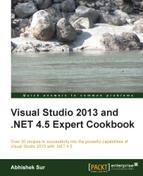The world is changing and the software industry is no exception. The software that exists today will be obsolete very soon. Introduction of new devices requires newer software. The changes are gradually reflected not only in the devices, but also in every sphere of the software industry—starting from natural language processing, embedded technology, micro-chip level programming, and so on. The hardware revolution asks for language enhancements to support better hardware. A high number of releases of software changes has always been common news for any developer. As a developer, it is very hard to know everything when a new release occurs. Learning continuously and gaining knowledge is the only way to survive in this dynamic software industry.
This book focuses on giving you expert advice on how to deal with changes in the software industry. It provides you with easy steps to deal with complex software problems. It gives you as many details as possible, and covers most of the technological domains in the world of .NET. This book is written in the form of recipes with step-by-step tutorials on every topic, where the developer accompanies the author in this wonderful journey into the known and hitherto unknown realms of .NET. This book presents you, as a developer, with easy steps to solve complex problems and thereby gives you the most relevant associated information that you would require. There is a special section (There's more…) for each recipe, which focuses on giving you extra knowledge on things that you might have missed. By the time you come to the end of this journey, you will enjoy the confidence that a clear understanding of .NET gives you.
This is a practical handbook that effectively utilizes the time spent while reading the book for the knowledge gained. This book is suitable for people who require solutions to problems in quick time, while providing a clear understanding of the topics with relevant sample code blocks. The examples given in this book are simple, easy to understand, and they map the user to port the same code with a few changes in the production environment. If you want to utilize your busy schedule to explore some of the ongoing technologies in the market, this book is for you.
Chapter 1, A Guide to Debugging with Visual Studio, focuses on giving you a basic understanding of the different environments set up inside Visual Studio and deals with all the necessary tools present inside Visual Studio to help in debugging a source. This chapter clarifies the debugging procedures in detail, followed by quick and easy sample code to help find bugs.
Chapter 2, Enhancements to WCF 4.5, deals with the Service Oriented Architecture using WCF. This chapter gives you knowledge on common problems that a developer needs to know and provides you with sample recipes to deal with them. It also gives a clear understanding on all the new features that come along with new releases.
Chapter 3, Building a Touch-sensitive Device Application Using Windows Phone 8, provides a quick introduction on device application development with the Windows Phone environment. This chapter provides simple solutions to some of the common problems when developing a Windows Phone application.
Chapter 4, Working with Team Foundation Server, deals with the source control functionality using Visual Studio ALM. The chapter provides detailed, step-by-step recipes to deal with development issues using a Team Foundation Server with the configuration and easy implementation of a successful TFS.
Chapter 5, Testing Applications Using Visual Studio 2013, provides a deeper insight on testing a full-fledged application. This chapter provides all the relevant information that you need to know about testing inside Visual Studio, enabling you to write tests quickly in easy steps, and a clear understanding of what is going on under the hood.
Chapter 6, Extending the Visual Studio IDE, focuses on presenting interesting facts related to adding more functionalities in Visual Studio. The need to customize Visual Studio itself is sometimes necessary to allow a developer to customize the tools inside the integrated environment. This chapter provides you with points that will help in dealing with extensions on the Visual Studio IDE in easy steps.
Chapter 7, Understanding Cloud Computing with Windows Azure, demonstrates the Microsoft implementation of cloud computing, enabling you to quickly adapt Azure in your own solution in easy steps. This chapter gives recipes to help a developer port their existing on-premise applications to the cloud.
